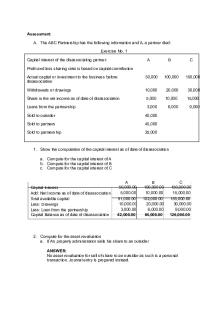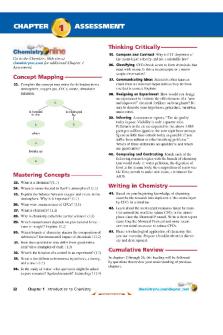Mtrejo Module 9Pain Assessment 120521 PDF

| Title | Mtrejo Module 9Pain Assessment 120521 |
|---|---|
| Course | Fundamentals of Professional Nursing |
| Institution | Rasmussen University |
| Pages | 4 |
| File Size | 49.2 KB |
| File Type | |
| Total Downloads | 19 |
| Total Views | 117 |
Summary
Week nine interview client on pain assessment paper....
Description
Melanie Trejo NU211/NUR2115 Section MTPB1A0S Fundamentals of Professional Nursing Module 09 Written Assignment - Pain Assessment Daria Wrobel December 5th, 2021
Pain Assessment Pain assessment is an integral part of nursing while caring for a client. For this assignment, I completed a pain assessment on a family member. While doing so, I used COLDERR, which stands for character, onset, location, duration, exacerbation, relief, and radiation. My family member shared that they are currently suffering from chronic pain. The pain, characterized by being sharp and achy. They also shared that it lasts for an hour for each flare-up. My family member's pain started about ten years ago after a sport acquired injury. Scans ruled out any breaks or tears in the knee. He also stated about the pain, "It starts whenever I step on the floor barefooted," "the cold always makes it worse." When asked what helps relieve the pain, they shared rubbing or massaging the knee and applying a warming pad. Elevation has also been enabled at times, but not all the time. The pharmacological intervention currently being used is the occasional use of acetaminophen. He also shared that he now works out four times a week and usually does not experience any pain. Also, he was in physical therapy but did not complete it due to believing it was not helping. There are currently no other pain-relieving methods taking place now. After completing the pain assessment, I started to identify two nursing non-pharmacological interventions that could be recommended to this family member. An appropriate recommendation would be an assistive device such as a knee brace. "A brace might help reduce pain by shifting your weight off the most damaged portion of your knee. Wearing a brace can improve your ability to get around and help you walk farther comfortably" (Mayo Clinic, 2021). Another non-pharmacological intervention would be to try acupuncture therapy. This type of therapy includes inserting thin needles into the body, promoting pain relief, and reducing inflammation.
The body releases endogenous opioid endorphins during the acupuncture process, which is its natural pain-relieving response. "Acupuncture is a good option to keep in mind to decrease pain, inflammation, and stiffness, and increase range of motion, in your knee. And that can improve your overall quality of life" (Cleaveland Clinic, 2021). After making both recommendations to the family member, he was interested in trying them. He has not tried Acupuncture for their pain, and it could be the remedy he needs. Chronic pain can harm a person's quality of life. Learning how to manage this pain is using different methods that can help maintain non-pain periods. As a nurse, it is your responsibility to understand all aspects of your client's pain and implement the best ways to help them manage it
References Mayo Foundation for Medical Education and Research. (2021, May 20). Knee braces for osteoarthritis. Mayo Clinic. https://www.mayoclinic.org/tests-procedures/knee-braces/about/pac20384791#:~:text=A%20brace%20might%20help%20reduce,braces%20used%20for%20knee %20arthritis. Team, W. (2021, August 27). How acupuncture helps arthritic knee pain. Cleveland Clinic. ttps://health.clevelandclinic.org/knee-arthritis-got-you-down-acupuncture-can-bring-relief/....
Similar Free PDFs

Module 2 Revised Assessment
- 2 Pages

Module 4 5 Assessment
- 7 Pages

Module 6 - GI GU Assessment
- 29 Pages

Module 1 - Assessment Part 1
- 2 Pages

Assessment OF Learning 1 Module
- 67 Pages
Popular Institutions
- Tinajero National High School - Annex
- Politeknik Caltex Riau
- Yokohama City University
- SGT University
- University of Al-Qadisiyah
- Divine Word College of Vigan
- Techniek College Rotterdam
- Universidade de Santiago
- Universiti Teknologi MARA Cawangan Johor Kampus Pasir Gudang
- Poltekkes Kemenkes Yogyakarta
- Baguio City National High School
- Colegio san marcos
- preparatoria uno
- Centro de Bachillerato Tecnológico Industrial y de Servicios No. 107
- Dalian Maritime University
- Quang Trung Secondary School
- Colegio Tecnológico en Informática
- Corporación Regional de Educación Superior
- Grupo CEDVA
- Dar Al Uloom University
- Centro de Estudios Preuniversitarios de la Universidad Nacional de Ingeniería
- 上智大学
- Aakash International School, Nuna Majara
- San Felipe Neri Catholic School
- Kang Chiao International School - New Taipei City
- Misamis Occidental National High School
- Institución Educativa Escuela Normal Juan Ladrilleros
- Kolehiyo ng Pantukan
- Batanes State College
- Instituto Continental
- Sekolah Menengah Kejuruan Kesehatan Kaltara (Tarakan)
- Colegio de La Inmaculada Concepcion - Cebu










